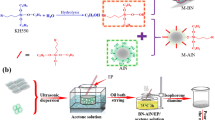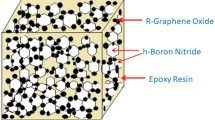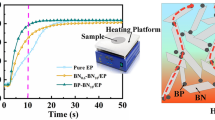Abstract
The increased heat generated in high-density electronics has intensified the search for advanced thermal management solutions. This urge has prompted fundamental studies on various filler-filled polymer composites with enhanced thermal performance. This research is intended to attain better understanding on the effect of particle sizes and geometry of fillers with different ratios of composition on the thermal and mechanical properties of hybrid composite system. It investigates the effect of combining polygonal aluminum oxide (Al2O3) and boron nitride (BN) platelets to enhance the thermal conductivity of epoxy composite. The surface of the two fillers was functionalized with aminopropyltriethoxysilane (KH550), thereby reducing the thermal interfacial resistance between filler and matrix. It was observed that there is no significant difference in the thermal and mechanical performance between BN1µm and BN5µm filler-filled composites. However, at filler loading of 30 wt%, the Al2O3 and BN1µm hybrid filler system (ratio 5:5) provided significant enhancement of maximum thermal conductivity of 0.57 Wm−1 K−1 compared to 0.17 Wm−1 K−1 that of neat epoxy. This synergistic effect results from the bridging of BN platelets between the Al2O3 particles facilitating the formation of effective thermal conductance network within the epoxy matrix.









Similar content being viewed by others
References
Donnay M, Tzavalas S, Logakis E (2015) Boron nitride filled epoxy with improved thermal conductivity and dielectric breakdown strength. Compos Sci Technol 110:152–158
Dittanet P, Pearson RA (2012) Effect of silica nanoparticle size on toughening mechanisms of filled epoxy. Polymer 53:1890–1905
Sebastian MT, Jantunen H (2010) Polymer-ceramic composites of 0–3 connectivity for circuits in electronics: a review. Int J Appl Ceram Technol 7:415–434
Boudenne A, Ibos L, Fois M, Majesté JC, Géhin E (2005) Electrical and thermal behaviour of polypropylene filled with copper particles. Compos Part A—Appl S 36:1545–1554
Anithambigai P, Shanmugan S, Mutharasu D, Zahner T, Lacey D (2014) Study on thermal performance of high power LED employing aluminum filled epoxy composite as thermal interface material. Microelectron J 45:1726–1733
Yu YH, Ma CCM, Teng C-C, Huang YL, Tien HW, Lee SH, Wang I (2013) Enhanced thermal and mechanical properties of epoxy composites filled with silver nanowires and nanoparticles. J Taiwan Inst Chem Eng 44:654–659
Qiao W, Bao H, Li X, Jin S, Gu Z (2014) Research on electrical conductive adhesives filled with mixed filler. Int J Adhes Adhes 48:159–163
Chung DDL (2001) Materials for thermal conduction. Appl Therm Eng 21:1593–1605
Park JG, Cheng Q, Lu J, Bao J, Li S, Tian Y, Liang Z, Zhang C, Wang B (2012) Thermal conductivity of MWCNT/epoxy composites: the effects of length, alignment and functionalization. Carbon 50:2083–2090
Huang J, Gao M, Pan T, Zhang Y, Lin Y (2014) Effective thermal conductivity of epoxy matrix filled with poly(ethyleneimine) functionalized carbon nanotubes. Compos Sci Technol 95:16–20
Lee JH, Rhee KY, Park SJ (2011) Silane modification of carbon nanotubes and its effects on the material properties of carbon/CNT/epoxy three-phase composites. Compos Part A—Appl Sci Manuf 42:478–483
Ma PC, Siddiqui NA, Marom G, Kim JK (2010) Dispersion and functionalization of carbon nanotubes for polymer-based nanocomposites: a review. Compos Part A—Appl Sci Manuf S41:1345–1367
Kume S, Yamada I, Watari K, Harada I, Mitsuishi K (2009) High-thermal-conductivity AlN filler for polymer/ceramics composites. J Am Ceram Soc 92:S153–S156
Xu Y, Chung DDL (2000) Increasing the thermal conductivity of boron nitride and aluminum nitride particle epoxy-matrix composites by particle surface treatments. Compos Interface 7:243–256
Chen CH, Jian JY, Yen FS (2009) Preparation and characterization of epoxy/γ-aluminum oxide nanocomposites. Compos Part A—Appl Sci Manuf 40:463–468
Geoffrey Pritchard, Novel and traditional fillers for plastics, Technology and Market Development. October 1999. Rapra technology Limited
Seran C, Kim JH (2013) Thermal conductivity of epoxy composites with a binary-particle system of aluminum oxide and aluminum nitride fillers. Compos Part B—Eng 51:140–147
Lee GW, Park M, Kim J, Lee JI, Yoon HG (2006) Enhanced thermal conductivity of polymer composites filled with hybrid filler. Compos Part A—Appl Sci Manuf 37:727–734
Gao Y, Gu A, Jiao Y, Yang Y, Liang G, Hu JT, Yao W, Yuan L (2012) High-performance hexagonal boron nitride/bismaleimide composites with high thermal conductivity, low coefficient of thermal expansion, and low dielectric loss. Polym Adv Technol 23:919–928
Yung KC, Liem H (2007) Enhanced thermal conductivity of boron nitride epoxy-matrix composite through multi-modal particle size mixing. J App Polym Sci 106:3587–3591
Im H, Hwang Y, Moon JH, Lee SH, Kim J (2013) The thermal conductivity of Al(OH)3 covered MWCNT/epoxy terminated dimethyl polysiloxane composite based on analytical Al(OH)3 covered MWCNT. Compos Part A—Appl Sci Manuf 54:159–165
Agrawal A, Satapathy A (2015) Mathematical model for evaluating effective thermal conductivity of polymer composites with hybrid fillers. Int J Therm Sci 89:203–209
Fu YX, He ZX, Mo DC, Lu SS (2014) Thermal conductivity enhancement with different fillers for epoxy resin adhesives. Appl Therm Eng 66:493–498
Sanada K, Tada Y, Shindo Y (2009) Thermal conductivity of polymer composites with close-packed structure of nano and micro fillers. Compos Part A—Appl Sci Manuf 40:724–730
Oleksy M, Szwarc-Rzepka K, Heneczkowski M, Oliwa R, Jesionowski T (2014) Epoxy resin composite based on functional hybrid fillers. Materials 7(8):6064
Yao Y, Zeng X, Guo K, Sun R, J-b Xu (2015) The effect of interfacial state on the thermal conductivity of functionalized Al2O3 filled glass fibers reinforced polymer composites. Compos Part A—Appl Sci Manuf 69:49–55
Li S, Qi S, Liu N, Cao P (2011) Study on thermal conductive BN/novolac resin composites. Thermochim Acta 523:111–115
Yuan FY, Zhang HB, Li X, Li XZ, Yu ZZ (2013) Synergistic effect of boron nitride flakes and tetrapod-shaped ZnO whiskers on the thermal conductivity of electrically insulating phenol formaldehyde composites. Compos Part A—Appl Sci Manuf 53:137–144
Karim MR, Rahman MA, Miah MAJ, Ahmad H, Yanagisawa M, Ito M (2011) Synthesis of γ-alumina particles and surface characterization. Open Colloid Sci J 4:32–36
Luis ASA, Prado Montira S, Marcos G, Ana Barros T, Karl S (2010) Surface modification of alumina nanoparticles with silane coupling agents. J Braz Chem Soc 21:2238–2245
Teng CC, Ma CCM, Chiou KC, Lee TM, Shih YF (2011) Synergetic effect of hybrid boron nitride and multi-walled carbon nanotubes on the thermal conductivity of epoxy composites. Mater Chem Phys 126:722–728
Jun H, Li GH, Na Y, Qin LL, Maryam EG, Zhang QX, Wang NY, Qu XW (2014) Preparation and characterization of surface modified boron nitride epoxy composites with enhanced thermal conductivity. RSC Adv 4:44282–44290
Milad Z, Mehrzad M, Babak S, Jam JE (2013) Fracture toughness of epoxy polymer modified with nanosilica particles: particle size effect. Eng Fract Mech 97:193–206
Hong JP, Yoon SW, Hwang T, Oh JS, Hong SC, Lee Y, Nam JD (2012) High thermal conductivity epoxy composites with bimodal distribution of aluminum nitride and boron nitride fillers. Thermochim Acta 537:70–75
Fu J, Shi L, Zhang D, Zhong Q, Chen Y (2010) Effect of nanoparticles on the performance of thermally conductive epoxy adhesives. Polym Eng Sci 50:1809–1819
Kuzak SG, Shanmugam A (1999) Dynamic mechanical analysis of fiber-reinforced phenolics. J Appl Polym Sci 73:649–658
Kim K, Kim J (2014) Fabrication of thermally conductive composite with surface modified boron nitride by epoxy wetting method. Ceram Intern 40:5181–5189
Ash BJ, Schadler LS, Siegel RW (2002) Glass transition behavior of alumina/polymethylmethacrylate nanocomposites. Mat Lett 55:83–87
Xiong M, Gu G, You B, Wu L (2003) Preparation and characterization of poly(styrene butylacrylate) latex/nano-ZnO nanocomposites. J Appl Polym Sci 90:1923–1931
Sun Y, Zhang Z, Moon K-S, Wong CP (2004) Glass transition and relaxation behavior of epoxy nanocomposites. J Polym Sci Pol Phys 42:3849–3858
Suriati G, Mariatti M, Azizan A (2011) Effects of filler shape and size on the properties of silver filled epoxy composite for electronic applications. J Mater Sci: Mater Electron 22:56–63
Acknowledgements
The authors would like to thank USM for the PRGS (1001/PFIZIK/846074) funding, and OSRAM Optosemiconductors (Malaysia) Sdn. Bhd. and OSRAM Optosemiconductors GmbH, Regensburg, Germany for characterization facilities.
Author information
Authors and Affiliations
Corresponding author
Ethics declarations
Conflict of interest
All the co-authors have seen and agreed with the contents of the manuscript and there is no financial interest to report. We certify that the submission is the original work by us and is not under review in any other publication. We also would like to justify that we do not have any conflict of interest to declare.
Rights and permissions
About this article
Cite this article
Permal, A., Devarajan, M., Hung, H.L. et al. Thermal and mechanical properties of epoxy composite filled with binary particle system of polygonal aluminum oxide and boron nitride platelets. J Mater Sci 51, 7415–7426 (2016). https://doi.org/10.1007/s10853-016-0016-3
Received:
Accepted:
Published:
Issue Date:
DOI: https://doi.org/10.1007/s10853-016-0016-3




